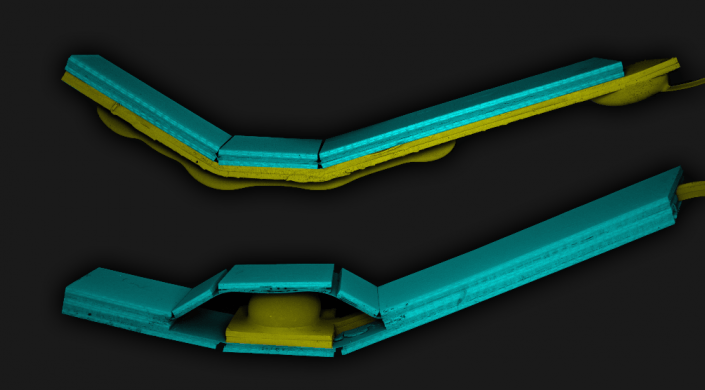Aug 3 2017
Although flexible endoscopes have the ability to make their way through narrow passages for curing hard-to-reach portions inside the human body, when they finally reach their target areas, they depend on firm surgical tools to remove or manipulate tissues. Such tools minimize the sensing and agility offered to Surgeons, thereby reducing the prevalent therapeutic potential of the endoscope.
 SEM images of the hybrid soft pop-up actuators. The image has been colored in post processing to differentiate between the soft (in yellow) and the rigid structure (in blue). CREDIT: Image courtesy of the Wyss Institute at Harvard University.
SEM images of the hybrid soft pop-up actuators. The image has been colored in post processing to differentiate between the soft (in yellow) and the rigid structure (in blue). CREDIT: Image courtesy of the Wyss Institute at Harvard University.
At present, Scientists at the Harvard John A. Paulson School of Engineering and Applied Sciences and the Wyss Institute for Biologically Inspired Engineering at Harvard University have created a hybrid rigid-soft robotic arm that offers high flexibility, integrated sensing and manifold degrees of freedom, for use with endoscopes. The robotic arm has been developed by means of a manufacturing technique combining soft lithography and pop-up fabrication. The robotic arm has the ability to be positioned flat on an endoscope until it reaches the target site. It then pops up to facilitate surgical procedures.
The study has been reported in a paper published in the Advanced Materials Technologies journal.
Soft robots are highly propitious for use in surgical procedures as they can be complementary to the human body’s stiffness, that is, they do not inadvertently rupture or rip through tissues. Yet, in the case of tiny areas, soft materials do not have the ability produce a force that is adequate enough to carry out surgical procedures.
At the millimeter scale, a soft device becomes so soft that it can’t damage tissue but it also can’t manipulate the tissue in any meaningful way. That limits the application of soft microsystems for performing therapy. The question is, how can we develop soft robots that are still able to generate the necessary forces without compromising safety.
Tommaso Ranzani, Co-author of the Paper and a Postdoctoral Fellow at SEAS and the Wyss Institute
Taking biology as the base, the Researchers created a hybrid design including a rigid skeleton enclosed by soft materials. The production technique was based on earlier research on origami-inspired, pop-up fabrication by Robert Wood, the Charles River Professor of Engineering and Applied Sciences.
Wood was the Co-author of the paper and is a Core Faculty Member of the Wyss Institute.
Earlier pop-up fabrication methods, for example, the ones applied in the case of Robobees, are dependent on actuation techniques that mandate the application of high temperatures or voltages to enable functioning, which will be highly unsafe in the case of a surgical tool directly operating on biological organs and tissues.
Therefore, the Scientists incorporated soft actuators in the pop-up actuator.
We found that by integrating soft fluidic microactuators into the rigid pop-up structures, we could create soft pop-up mechanisms that increased the performance of the actuators in terms of the force output and the predictability and controllability of the motion. The idea behind this technology is basically to obtain the best of both worlds by combining soft robotic technologies with origami-inspired rigid structures. Using this fabrication method, we were able to design a device that can lie flat when the endoscope is navigating to the surgical area, and when the surgeon reaches the area they want to operate on, they can deploy a soft system that can safely and effectively interact with tissue.
Sheila Russo, Lead Author of the Paper and Postdoctoral Fellow at SEAS and Wyss
Powered just by water, these soft actuators are connected to the rigid components by means of an irrevocable chemical bond without using adhesives. The Researchers displayed the consolidation of simple capacitive sensing which we can apply to measure forces delivered to the tissue and to enable the surgeon to know the exact location of the arm and also its movement.
The manufacturing technique enables bulk production of the robotic arm, which is significant in the case of medical devices. The technique also enables the achievement of higher complexity levels for enhanced actuation and sensing. Moreover, the materials used for fabricating the arm are biocompatible.
The arm also includes a suction cup, which is based on the principle of tentacles of an octopus. The suction cup enables the arm to have a safely contact with the tissues. The Researchers performed an ex vivo investigation of the device, replicating a complex endoscopic procedure performed on pig tissue. The arm was successful in safe handling of the tissue.
“The ability to seamlessly integrate gentle yet effective actuation into millimeter-scale deployable mechanisms fits naturally with a host of surgical procedures,” stated Wood. “We are focused on some of the more challenging endoscopic techniques where tool dexterity and sensor feedback are at a premium and can potentially make the difference between success and failure.”
The team exhibited that the dimensions of the robotic arm can be reduced to 1 mm, thus enabling it to be applied for performing tighter endoscopic procedures, for example, in the brain or lungs.
In the future, the team aims to perform in vivo investigation of the device.
Our technology paves the way to design and develop smaller, smarter, softer robots for biomedical applications.
Sheila Russo, Lead Author of the Paper and Postdoctoral Fellow at SEAS and Wyss
A patent application for this technology has been filed by Harvard’s Office of Technology Development, which is vivaciously looking forward to prospects for commercialization.
Conor Walsh, the John L. Loeb Associate Professor of Engineering and Applied Sciences and Core Faculty Member of the Wyss Institute, was the Co-author of the paper.
The DARPA “Atoms to Product” program and the Wyss Institute for Biologically Inspired Engineering supported the study.